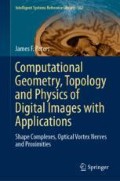Abstract
This chapter takes a look at the Alexandroff version of the Brouwer–Lebesgue tiling theorem and introduces systems of nerve complexes that have proximity to each other and which are known shapes that cover all or part of the interior of unknown surface shapes in visual scenes.
Access this chapter
Tax calculation will be finalised at checkout
Purchases are for personal use only
Notes
- 1.
This sample shape is produced using the Mathematica script from https://www.mathematica.stackexchange.com/questions/23546/.
- 2.
Many thanks for Arjuna P. H. Don for this photo.
- 3.
Many thanks to Sheela Ramanna for contributing this picture.
References
Lebesgue, H.: Sur les fonctions représentables analytiquement. J. de Math. 6(1), 139–216 (1905)
Sagan, H.: Universitext. Space-filling curves, p. xvi+193. Springer, New York (1994). ISBN: 0-387-94265-3, MR1299533
Brouwer, L.: Beweis der invarianz der dimensionenzahl (german). Math. Ann. 70, 161–165 (1911). Zbl JFM 42.0416.02, reviewer Prof. Bklaschke
Brouwer, L.: Über den natürlichen dimensionsbegriff (german). J. füar Math. 142, 146–152 (1913). Zbl JFM 44.0555.01, reviewer Prof. Bklaschke
Adams, C., Morgan, F., Sullivan, J.: When soap bubbles collide. arXiv 0412(020v3), 1–9 (2006)
Salepci, N., Welshinger, J.Y.: Tilings, packings and expected betti numbers in simplicial complexes. arXiv 1806(05084v1), 1–28 (2018)
Grünbaum, B., Shephard, G.: Tilings and Patterns, pp. Xii+700. W.H. Freeman and Co, New York (1987). MR0857454
NASA: Martian olympus mon volcano crater. Technical report, Jet Propulsion Laboratory/Caltech (2018). https://mars.jpl.nasa.gov/gallery/atlas/images/oly.jpg
Buslaev, A., Tatashev, A.: Exact results for discrete dynamical systems on a pair of contours. Math. Methods Appl. Sci. 41(17), 1–12 (2018). https://doi.org/10.1002/mma/4822
Lewis, G., Tolman, R.: The principle of relativity, and non-Newtonian mechanics. Proc. Am. Acad. Arts Sci. 44(25), 711–724 (1909). https://www.jstor.org/stable/20022495
Susskind, L., Friedman, A.: Quantum Mechanics. The Theoretical Minimum, xx+364 pp. Penguin Books, UK (2014). ISBN: 978-0-141-977812
Malecki, K.: Graph cellular automata with relation-based neighbourhoods of cells for complex systems modelling: A case of traffic simulation. Symmetry 9(12), 322 (2017). https://doi.org/10.3390/sym9120322
Nagel, K., Schreckenberg, M.: A cellular automaton model for freeway traffic. J. Phys. I Francey 2(12), 2221–2229 (1992). https://doi.org/10.1051/jp1:1992277
Flammini, A., Stasiak, A.: Natural classification of knots. Proc. R. Soc. Lond. Ser. A Math. Phys. Eng. Sci. 463(2078), 569–582 (2017). MR2288834
Toffoli, S.D., Giardino, V.: Forms and roles of diagrams in knot theory. Erkenntnis 79(4), 829–842 (2014). MR3260948
Peters, J.: Foundations of Computer Vision. Computational Geometry, Visual Image Structures and Object Shape Detection, Intelligent Systems Reference Library 124. Springer International Publishing, Switzerland (2017). i–xvii, 432 pp. https://doi.org/10.1007/978-3-319-52483-2, Zbl 06882588 and MR3768717
Peters, J., Tozzi, A., Ramanna, S.: Brain tissue tessellation shows absence of canonical microcircuits. Neurosci. Lett. 626, 99–105 (2016). https://doi.org/10.1016/j.neulet.2016.03.052
Tozzi, A., Peters, J., Deli, E.: Towards plasma-like collisionless trajectories in the brain. Neurosci. Lett. 662, 105–109 (2018)
Cui, E.: Video vortex cat cycles part 1. Technical report, University of Manitoba, Computational Intelligence Laboratory, Deparment of Electrical & Computer Engineering, U of MB, Winnipeg, MB R3T 5V6, Canada (2018). https://youtu.be/rVGmkGTm4Oc
Cui, E.: Video vortex cat cycles part 2. Technical report, University of Manitoba, Computational Intelligence Laboratory, Deparment of Electrical & Computer Engineering, U of MB, Winnipeg, MB R3T 5V6, Canada (2018). https://youtu.be/yJBCdLhgcqk
Ahmad, M., Peters, J.: Proximal C̆ech complexes in approximating digital image object shapes. Theory and application. Theory Appl. Math. Comput. Sci. 7(2), 81–123 (2017). MR3769444
Baldomir, D., Hammond, P.: Geometry of Electromagnetic Systems, p. xi+239. Clarendon Press, Oxford (1996). Zbl 0919.76001
Milnor, J.: Morse Theory. Based on Lecture Notes by M. Spivak and R. Wells, vi+153 pp. Princeton University Press, Princeton (1963). MR0163331
Boxer, L.: Multivalued functions in digital topology. Note di Matematica 37(2), 61–76 (1909). https://doi.org/10.1285/i15900932v37n2p61
Peters, J.: Proximal vortex cycles and vortex nerve structures. Non-concentric, nesting, possibly overlapping homology cell complexes. J. Math. Sci. Modell. 1(2), 56–72 (2018). ISSN 2636-8692, www.dergipark.gov.tr/jmsm, See, also, arXiv:1805.03998
Worsley, A., Peters, J.: Enhanced derivation of the electron magnetic moment anomaly from the electron charge from geometric principles. Appl. Phys. Res. 10(6), 24–28 (2018). https://doi.org/10.5539/apr.v10n6p24
Yurkin, Peters, J., Tozzi, A.: A novel belt model of the atom, compatible with quantum dynamics. J. Sci. Eng. Res. 5(7), 413–419 (2018)
Hamrouni, L., Bensaci, R., Kherfi, M., Khaldi, B., Aiadi, O.: Automatic recognition of plant leaves using parallel combination of classifiers. In: Amine, A., Mouhoub, M., Mohamed, O.A., Djebbar, B. (eds.) Computational Intelligence and Its Applications, pp. 597–606. Springer International Publishing, Switzerland (2018). https://doi.org/10.1007/978-3-319-89743-1_51
Author information
Authors and Affiliations
Corresponding author
Rights and permissions
Copyright information
© 2020 Springer Nature Switzerland AG
About this chapter
Cite this chapter
Peters, J.F. (2020). Brouwer–Lebesgue Tiling Theorem and Nerve Complexes That Cover Surface Shapes. In: Computational Geometry, Topology and Physics of Digital Images with Applications. Intelligent Systems Reference Library, vol 162. Springer, Cham. https://doi.org/10.1007/978-3-030-22192-8_8
Download citation
DOI: https://doi.org/10.1007/978-3-030-22192-8_8
Published:
Publisher Name: Springer, Cham
Print ISBN: 978-3-030-22191-1
Online ISBN: 978-3-030-22192-8
eBook Packages: Intelligent Technologies and RoboticsIntelligent Technologies and Robotics (R0)

